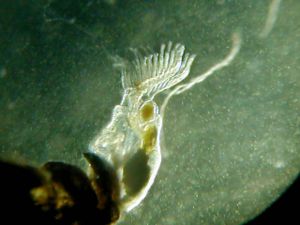- Lophopoda
-
Süßwassermoostierchen Systematik Abteilung: Gewebetiere (Eumetazoa) Unterabteilung: Bilateria ohne Rang: Urmünder (Protostomia) Überstamm: Lophotrochozoen (Lophotrochozoa) Stamm: Moostierchen (Bryozoa) Klasse: Süßwassermoostierchen Wissenschaftlicher Name Phylactolaemata Ordnungen - Plumatellida
Die Süßwassermoostierchen bilden eine Klasse der Moostierchen (Ectoprocta oder Bryozoa), die im Gegensatz zu allen anderen Klassen dieses Tierstammes ausschließlich im Süßwasser (limnisch) vorkommt. Diese in der Systematik als Phylactolaemata bezeichnete Klasse umfasst nur eine einzige Ordnung, die Plumatellida, mit fünf Familien. Die Phylactolaemata werden bisweilen auch als Lophopoda bezeichnet.
Inhaltsverzeichnis
Bau
Die Süßwassermoostierchen sind meist in stehenden Gewässern zu finden, sei es als Überzug auf Steinen, an der Unterseite von See- und Teichrosenblättern oder auf ins Wasser hängenden Zweigen. Von den über 5000 rezenten Arten der Moostierchen, die insgesamt bekannt sind, gehören nur rund 74 zu den Süßwassermoostierchen, von denen 19-20 in Europa heimisch sind. Die neueste in Europa (Italien) entdeckte Art ist: Plumatella vaihiriae, die bisher nur aus Tahiti, Hawaii, Nordamerika, Argentinien und Thailand bekannt war.[1]
Die Zooecien bestehen nicht wie bei den marinen Moostierchen aus Kalk, sondern aus Chitin verschiedener Konsistenz. Dadurch können die Kolonien gallertige oder krustenartige Überzüge bilden, manchmal sind auch verzweigte Formen zu finden. Bei manchen Arten können die Kolonien bis zu über 1 kg schwere Klumpen bilden. Die Süßwassermoostierchen sind an den Wechsel der Jahreszeiten angepasst, indem sie im Herbst Dauerstadien (Statoblasten) bilden, die der Überwinterung dienen.
Systematik
- Klasse: Süßwassermoostierchen
- Ordnung: Plumatellida
- Familie: Cristatellidae
- Gattung: Cristatella
- Familie: Fredericellidae
- Gattung: Fredericella, Internectella
- Familie: Lophopodidae
- Gattungen: Asajirella, Lophopodella, Lophopus
- Familie: Pectinatellidae
- Gattungen: Pectinatella
- Familie: Plumatellidae
- Gattungen: Afrindella, Australella, Gelatinella, Hyalinella, Plumatella, Stolella, Swarupella, Varunella
- Familie: Stephanellidae [2]
- Gattung: Stephanella
- Familie: Cristatellidae
- Ordnung: Plumatellida
Literatur
- Geimer, G. & J.A. Massard (1986): Les Bryozoaires du Grand-Duché de Luxembourg et des régions limitrophes. Travaux Scientifiques du Musée d'Histoire Naturelle de Luxembourg, 7: 1-187.
- Lacourt, A.W. (1968): A monograph of the freshwater Bryozoa: Phylactolaemata. Zoölogische Verhandelingen, 93: 1-159.
- Massard, J.A. & G. Geimer (2008): Global diversity of bryozoans (Bryozoa or Ectoprocta) in freshwater: an update. Bulletin de la Société des Naturalistes luxembourgeois, 109: 139-148
- Wesenberg-Lund, C. (1939): Biologie der Süsswassertiere. Wirbellose Tiere. Wien, J. Springer, 817 p. (reprint 1982, Vlg. J. Cramer, Braunschweig u. Vlg. O. Koeltz, Koenigstein). (Bryozoa: 369-394).
- Wiebach, F. (1960): Bryozoa. In: P. Brohmer et al. (Hrsg.): Die Tierwelt Mitteleuropas, 1(8), Leipzig: 1-56, Tfl. 1-19.
- Wood, T.S. & B. Okamura (2005): A new key to the freshwater bryozoans of Britain, Ireland and Continental Europe, with notes on their ecology. Freshwater biological Association Scientific Publication, 63: 1-113.
- Wöss, E. (2005): Moostiere (Bryozoa). Denisia 16: 1-369 (Kataloge der Oberösterreichischen Landesmuseen, N.S. 28).
Einzelnachweise
- ↑ Taticchi, M.I., G. Pieroni & A.C. Elia (2008): First finding of Plumatella vaihiriae (Hastings, 1929) (Bryozoa, Phylactolaemata) in Europe. Italian Journal of Zoology, 75(4): 411-416 (nicht bei Massard & Geimer 2008 berücksichtigt).
- ↑ Siehe: M. Hirose, M.H. Dick & S.F. Matawari: Molecular phylogenetic analysis of phylactolaemate bryozoans based on mitochondrial gene sequences. In: Bryozoan Studies 2007 (eds. S.J. Hageman, M.M. Key, J.E. Winston). Virginia Museum of Natural History Special Publication Number 15, Martinsville, Virginia 2008: 65-74. Siehe auch: Massard & Geimer 2008, S. 140f, Tab. 1, Anmerkung g.
Weblinks
Wikimedia Foundation.

